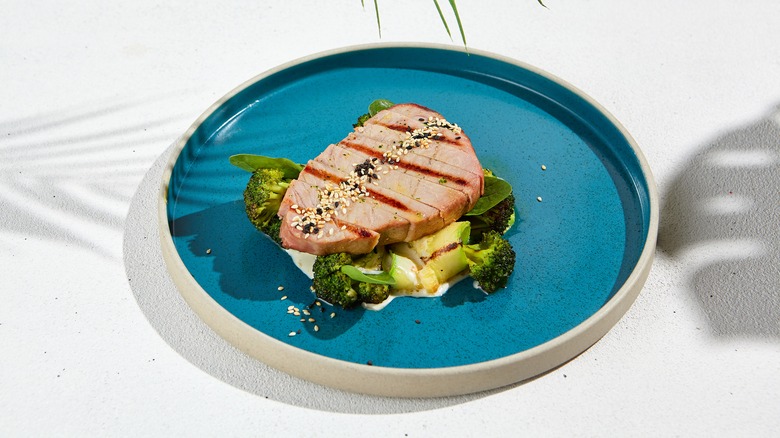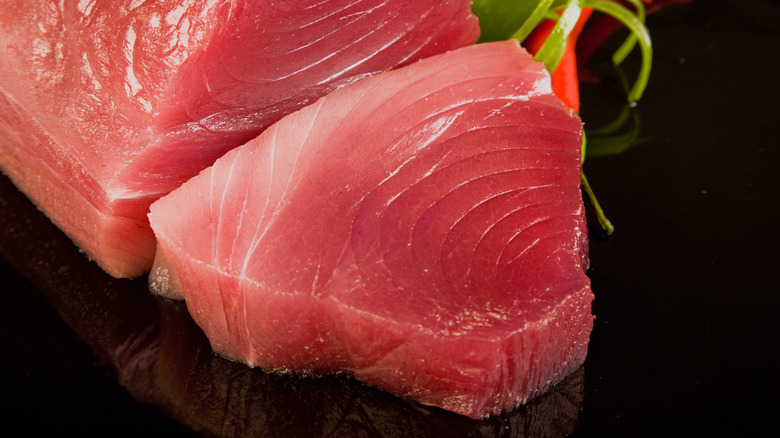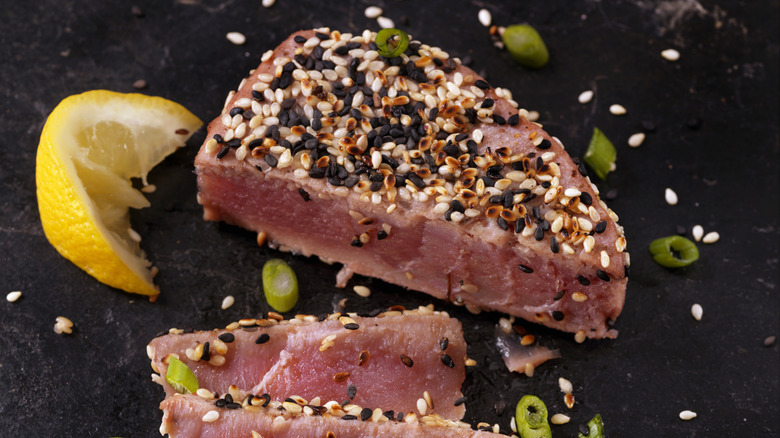The Best Type Of Tuna To Cook On The Grill
When the grill comes out for the season, it's easy to get hung up on the classics: burgers, hot dogs, or some perfectly charred veggies. But let's not leave tuna out of the picture. A little grilled salt and pepper tuna is a great way to break up a meat-heavy cookout (and you can even use the leftovers for grilled tuna sandwiches).
But, with it being such a large fish, what is the best part of the tuna to grill? According to Executive Chef Victoriano Lopez, of La Mar Cocina Peruana in San Francisco, it is the "tuna belly, collar, cheeks, and tail" that are best, as they contain fat and collagen, "which help make the tuna very juicy," he adds.
Fatty tuna belly from mature bluefins is often prized in sushi making, too, where it's known as toro. Typically this part of the fish is divided into two categories: chutoro, which is somewhat fatty; and otoro, which is the fattiest and most valuable piece of the fish, known for its melt-in-your-mouth texture.
Fish cheeks are also extremely tender and delicious, and particularly special because of their small size. The same goes for fish collars, triangle-shaped cuts that lie just past the cheeks in the neck area. These are harder to find, but well worth looking for. So are tuna tail cuts, which are often discarded because they are somewhat difficult to work with due to their stiff connective tissue and bony exterior.
Cooking with other parts of tuna
According to Chef Victoriano Lopez, "Other parts [of the tuna] can also be grilled, but make sure to serve [them] medium rare with a red inside so that [they] don't lose all of the juice." Lopez insists that this requires a very quick sear on both sides. "If cooked for too long," he adds, "it will be a well done tuna steak that will be dry and lose much of its fresh flavor."
Most tuna steaks purchased at the grocery store will come from the loin of the fish, which is leaner. As this is generally the part of the fish from which canned tuna is made, that should give you an idea of the difference in texture after cooking the lean loin versus the fatty belly.
But it will still be tasty if cooked very rare; according to Chef Lopez, "tuna is best for raw dishes such as ceviche, tiraditos, tartar, etc." Luckily, rare and raw tuna is generally pretty safe to eat, if purchased from a reputable vendor. But if you're concerned about food safety, you can freeze your tuna for a week before cooking, then thaw it right before you put it on the grill, in order to kill off any parasites.
Other tips for grilling tuna
Chef Victoriano Lopez also recommends that you should clean your grill thoroughly to avoid the protein from sticking, and make sure it is well greased with olive, coconut, or avocado oil and piping hot before cooking your fish. Mayonnaise is also great for making moist tuna steaks — coating your fish lightly with it will help prevent sticking or drying out.
Popping your tuna in a quick acidic marinade before grilling can also prevent your steak from losing its juiciness, as a touch of vinegar or citrus juice will help lightly cure your fish. (Just don't let it marinate for too long, though, or the acid could ruin the texture of your tuna.) This also has the upside of imbuing your tuna steak with lots of flavor.
Once your tuna has been cooked, don't worry about letting it rest. You can cut it immediately, and then serve it with a lovely salsa, some herby butter, or a flavorful chimichurri.



